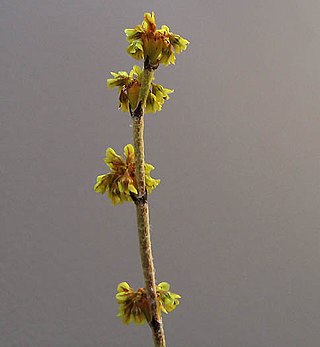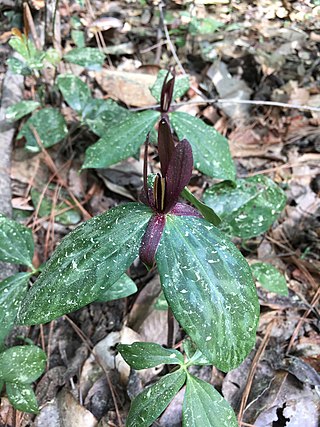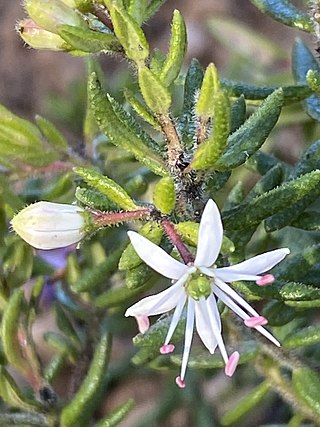
Agrostemma is a genus of annual plants in the family Caryophyllaceae, containing the species known as corncockles. Its best-known member is A. githago, the common corncockle, which is a native of Europe. The species is a weed of cereals and other crops, probably with a centre of origin in the eastern Mediterranean. It occurs as a weed worldwide, but is declining in its native range because of improved seed cleaning. Agrostemma gracile, the slender corncockle, is only found in central Greece near the city of Farsala. Corncockle is an attractive plant, and its seeds are still commercially available to gardeners.
Gracilis, a Latin adjective meaning slender, graceful or gracile, may refer to :

Daphniphyllum is the sole genus in the flowering plant family Daphniphyllaceae and was described as a genus in 1826. The genus includes evergreen shrubs and trees mainly native to east and southeast Asia, but also found in the Indian Subcontinent and New Guinea.

The Brazilian gracile opossum is a species of small opossum from Brazil.

Tropidocarpum is a genus of flowering plants in the family Brassicaceae. There are two to four species, one of which is extremely rare. Tropidocarpum capparideum, the caper-fruited tropidocarpum, is a plant endemic to California generally considered to be extinct since the 1950s, but has been reported since. Specimens were collected at Fort Hunter Liggett, California, in 2000 and 2001. Its status is currently in debate. The other member of the genus, the dobie pod, T. gracile, is a common mustardlike plant in California and Baja California. It is proposed that two other plants in separate monotypic genera, Twisselmannia and Agallis, be moved to Tropidocarpum.

Eriophorum gracile is a species of flowering plant in the sedge family, Cyperaceae. It is known by the common name slender cottongrass, or slender cottonsedge. Eriophorum gracile is a plant with circumboreal distribution, extending south into mountain ranges of the Northern Hemisphere. It grows in wet areas such as bogs.

Lepidocaryum is a monotypic genus of flowering plant in the palm family from South America where the lone species, Lepidocaryum tenue, is commonly called poktamui. Nine species names have been published, but palm taxonomists currently agree that just one variable species includes them all. The most reduced member of the Lepidocaryeae, it is similar in appearance to three closely related genera, Mauritia, Mauritiella, and Lytocaryum. The genus name combines the Greek words for "scale" and "nut" and the species epithet is Latin for "thin".

Eriogonum gracile is a species of wild buckwheat known by the common name slender woolly buckwheat.

Xanthisma gracile is a species of annual flowering plant in the family Asteraceae known by the common names slender goldenweed and annual bristleweed.
Gracility is slenderness, the condition of being gracile, which means slender. It derives from the Latin adjective gracilis, or gracile (neuter), which in either form means slender, and when transferred for example to discourse takes the sense of "without ornament", "simple" or various similar connotations.

Robust capuchin monkeys are capuchin monkeys in the genus Sapajus. Formerly, all capuchin monkeys were placed in the genus Cebus. Sapajus was erected in 2012 by Jessica Lynch Alfaro et al. to differentiate the robust (tufted) capuchin monkeys from the gracile capuchin monkeys, which remain in Cebus.

Gracile capuchin monkeys are capuchin monkeys in the genus Cebus. At one time all capuchin monkeys were included within the genus Cebus. In 2011, Jessica Lynch Alfaro et al. proposed splitting the genus between the robust capuchin monkeys, such as the tufted capuchin, and the gracile capuchins. The gracile capuchins retain the genus name Cebus, while the robust species have been transferred to Sapajus.
Dipodium gracile is an orchid species that is native to Sulawesi in Indonesia. The species was formally described in 1911 by German botanist Rudolf Schlechter.

Trillium gracile, commonly known as the Sabine River wakerobin, slender trillium, or graceful trillium, is a species of flowering plant in the family Melanthiaceae. It is native to the region along the Sabine River in western Louisiana and eastern Texas. It generally grows in mature pine and hardwood forests, and on riverbanks.
Ponerorchis gracilis is a species of plant in the family Orchidaceae. It is commonly known as delicate amitostigma. It is widespread across much of eastern Asia. It has been reported from Japan, Korea, Taiwan, and China.

Silphium radula, commonly known as roughstem rosinweed, is a species of flowering plant in the family Asteraceae. It is native North America, where it is found in the South Central region of the United States. Its natural habitat is prairies over sandy or calcareous soil.

Marsippospermum gracile, common name alpine rush, is a flowering plant species in the rush family Juncaceae which is native to New Zealand.

Leionema gracile, commonly known as Mt Greville phebalium, is a shrub species that is endemic to Queensland, Australia. It is a small shrub with spreading leaves, white petals and flowers from autumn to spring.

Argyranthemum gracile, called the Tenerife white marguerite, is a species of flowering plant in the genus Argyranthemum, native to Tenerife in the Canary Islands. Its cultivar 'Chelsea Girl' has gained the Royal Horticultural Society's Award of Garden Merit.

Nothoscordum gracile, also known as slender false garlic, or fragrant onion, is a bulbous plant belonging to the Amaryllidaceae family. Native from southern Mexico to western South America, the species is used as an ornamental plant due to its showy inflorescences and the fragrance of its flowers.















